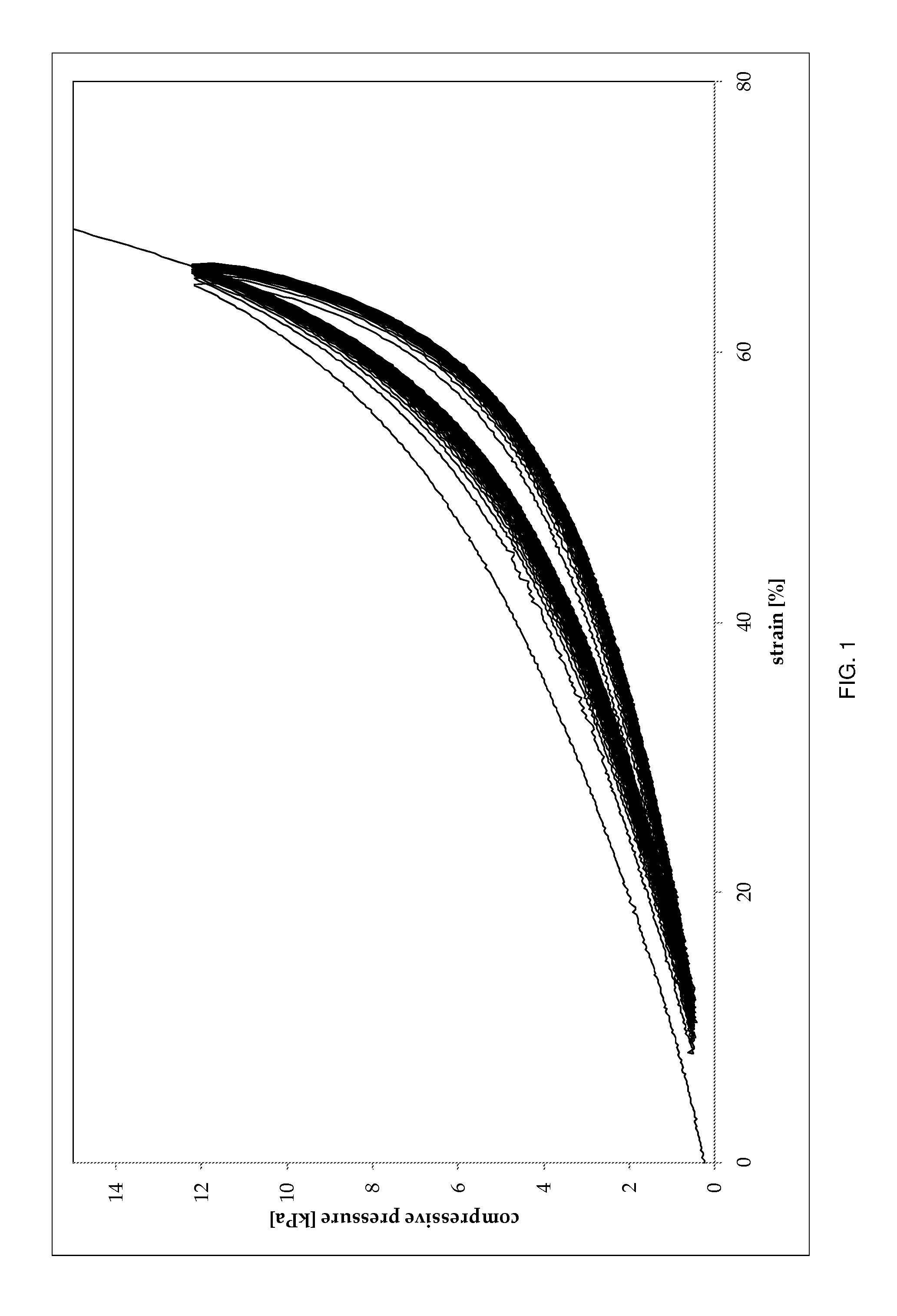Collagen sponge
a chemically crosslinked, collagen sponge technology, applied in the direction of prosthesis, peptide/protein ingredients, bandages, etc., can solve the problems of soft tissue volume augmentation, pressure on the regenerative device, and limitations in the quality and quantity of tissue to be recovered
- Summary
- Abstract
- Description
- Claims
- Application Information
AI Technical Summary
Benefits of technology
Problems solved by technology
Method used
Image
Examples
example 1
Preparation of a Slurry of Collagen Fibres Derived from Porcine Peritoneum
[0092]The peritoneal membranes from young pigs were completely freed from flesh and grease by mechanical means, washed under running water and treated with 2% NaOH solution for 12 hours. The membranes were then washed under running water and acidified with 0.5% HCl. After the material had been acidified through its entire thickness (about 15 min) the material was washed until a pH of 3.5 was obtained. The material was then shrunk with 7% saline solution, neutralised with 1% NaHCO3 solution and washed under running water. The material was then dehydrated with acetone and degreased with n-hexane.
[0093]The material was dried using ethanol ether and milled with a cutting mill (e.g. Pulverisette 25 from Fritsch: see fritsch.de. / produkte / mahlen / schneidmuehlen / pulverisette-25 or SM300 from Retsch: retsch.de / de / produkte / zerkleinern / schneidmuehlen) which includes a trapezoidal sieve of 0.5 to 1.0 mm.
[0094]A 4% (w / w) sl...
example 2
Preparation of a Slurry of Collagen Fibres Derived from a Sterile Geistlich Bio-Gide® Membrane
[0095]A Geistlich Bio-Gide® membrane (available from Geistlich Pharma AG, CH-6110, Switzerland) was dried and milled with a cutting mill which includes a trapezoidal sieve of 0.5 to 1.0 mm. A 4% (w / w) collagen slurry of collagen fibres and a 6% (w / w) collagen slurry of collagen fibres were prepared by suspending adequate amounts of the dried powder in water and adjusting the pH to 2.6 with 10 mM hydrochloric acid.
example 3
Preparation of a Slurry of Collagen Fibres Derived from Pig Dermis
[0096]Porcine hides were ground in a meat grinder to pieces of 1 to 20 mm. The water was removed using a water soluble solvent such as an alcohol or a ketone. The collagen fibres were defatted using a chlorinated hydrocarbon such as dichloroethane or methylene chloride or a non-chlorinated hydrocarbon such as hexane or toluene. After removing the solvent the collagen was treated with a strong inorganic base at a pH above 12 for a period of 6 to 24 hours and treated with a strong inorganic acid at a pH of 0 to 1 for a period of 1 to 12 hours. The excess acid was removed by rinsing with water and the suspension was homogenized by colloid milling to a 0.5 to 2% homogenous suspension of collagen fibres in the presence of a swelling regulator such as an inorganic salt. The suspension was dried by freeze-drying and the dry collagen fibres were successively cleaned with different organic solvents such as alcohols, ethers, ke...
PUM
| Property | Measurement | Unit |
|---|---|---|
| Temperature | aaaaa | aaaaa |
| Temperature | aaaaa | aaaaa |
| Length | aaaaa | aaaaa |
Abstract
Description
Claims
Application Information
 Login to View More
Login to View More - R&D
- Intellectual Property
- Life Sciences
- Materials
- Tech Scout
- Unparalleled Data Quality
- Higher Quality Content
- 60% Fewer Hallucinations
Browse by: Latest US Patents, China's latest patents, Technical Efficacy Thesaurus, Application Domain, Technology Topic, Popular Technical Reports.
© 2025 PatSnap. All rights reserved.Legal|Privacy policy|Modern Slavery Act Transparency Statement|Sitemap|About US| Contact US: help@patsnap.com


